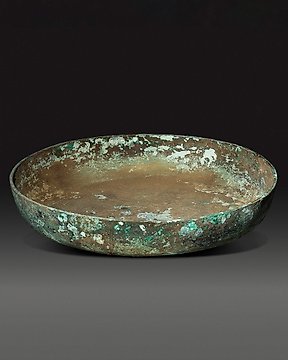
Etruscă Bronz farfurie farfurie. secolele VI – V î.Hr. 27,5 cm D. Foarte frumos
Nr. 85843597

Nr. 85843597

Hercules Figure.
Etruscan, 6th century BC.
Dimensions: 7 cm height.
Condition: Good condition, intact.
Provenance: Private collection, Paris, France. 1970.
Description:
Solid bronze sculptural representation of the Greek hero Heracles, known to the Romans as Hercules.
Heracles is the most famous hero in Greek mythology and perhaps also in all classic antiquity. His name comes from the goddess Hera and the Greek word “kleos” (glory), meaning “the glory of Hera”. He was considered to be the son of Zeus and Alceme, a mortal queen, foster son of Amphitryon and great-grandson of Perseus on his mother’s side. At birth he was given the name of Alcaeus or Alcides, in honour of his grandfather. This very word evokes the idea of strength. It was as an adult that he received the name with which he is known, imposed on him by Apollo through the Pythia, to indicate his condition as a follower of the goddess Hera. In ancient Rome as in Western Europe, he is better known as Hercules, and some Roman emperors, Commodus and Maximian among others, identified with his figure.
His extraordinary strength is the most important of his attributes, but he is also known for courage, pride, a certain candour and formidable sexual prowess. He is considered to be the forbear of the kings of Sparta, and this was one of the reasons for the dissemination of his legend and cult, making Heracles the Dorian hero par excellence. There are many stories in mythology about him; the most important one is that of the Twelve Labours of Heracles. The stories in which he has the leading role form a cycle which is constant through all antiquity and for this reason it is difficult to give a chronological, or even a coherent exposition of them.
The technique of lost wax casting is a sculptural procedure using a mould made from a prototype of the piece to be worked, and this prototype is usually made from beeswax. This is covered with a thick layer of soft material, usually clay, which then solidifies. Once this has hardened it is put in a kiln where the wax inside melts and leaks out from expressly made holes in the clay. In its place molten metal is injected and this takes on the exact form of the mould. To extract the final piece the mould must be removed.
Notes:
- The piece includes authenticity certificate.
- The piece includes Spanish Export License (Passport for European Union) - If the piece is destined outside the European Union a substitution of the export permit should be requested, can take between 1-2 weeks maximum.
- The seller guarantees that he acquired this piece according to all national and international laws related to the ownership of cultural property. Provenance statement seen by Catawiki.
#ancientolympics
Cum să cumperi de la Catawiki
1. Descoperă ceva special
2. Plasează cea mai mare ofertă
3. Fă o plată sigură